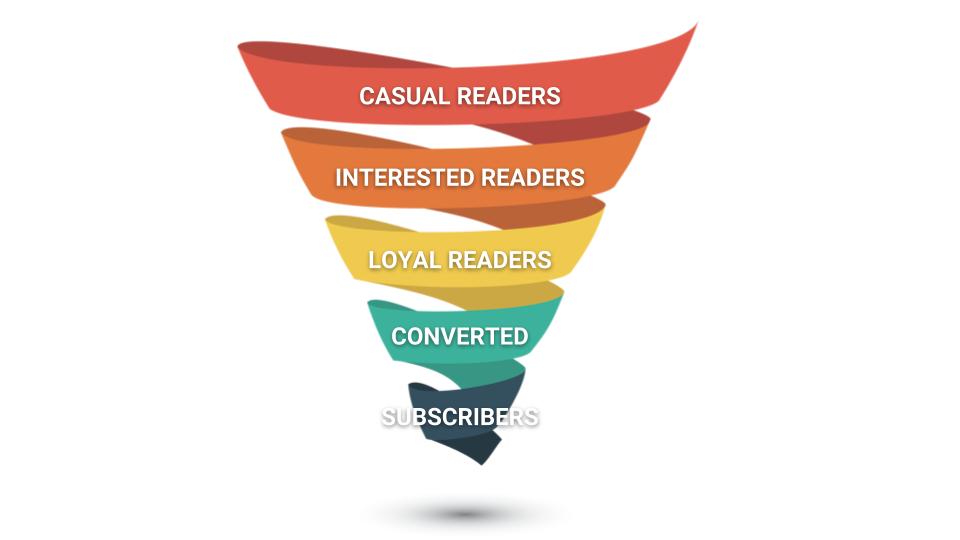What do you think of when you hear the word “funnel?” Before I became a media reporter, I thought of the Tin Man’s hat from “Wizard of Oz.” Or those delicious cakes dusted in powdered sugar at the fair.
Now, I think of this concept that’s becoming pretty popular in newsrooms that are trying to better understand and attract audiences. Maybe you remember hearing about the funnel with that buzzword-packed Tronc video from a few years ago.
Erica Smith, online editor and director of digital strategy at The Virginian-Pilot, knew the concept before she worked in journalism.
“I worked at a marketing agency for awhile, and funnels often were used to develop plans and show progress,” she said. “I also was familiar with funnels in relation to the lean startup model.”
The Virginian-Pilot was part of Poynter’s first Table Stakes class, and that’s when Smith first heard the concept applied to journalism. She spoke with me this week via email about how the Pilot is thinking about funnels and why it’s a term that could use a lot more clarity.
The funnel concept is usually applied to turning readers into subscribers/supporters
The Economist has a detailed piece on how big and small newsrooms approach the concept. WIth the Pilot’s digital subscription funnel, Smith said, there are five levels. Here’s a graphic she shared.

“So for us, it starts with awareness — the number of people coming to our site, particularly local users,” Smith said. “We're also interested in how they're learning about us. Social media and search are great tools to build awareness. This stage is mostly filled by the newsroom — we tell stories that bring people to the website or our digital products.”
Engagement: “We're interested in how many pages those users (particularly the local ones) are looking at, how much time they're spending and how many people are coming back for more. There are also some more obvious signs of engagement, like story comments.”
Registration “shifts a bit from the newsroom and into other departments. People can register for a subscription, of course, but also for a newsletter and a comment account.”
Conversion and retention: These look closer at digital-only subscriptions and keeping those subscribers, Smith said.
The Pilot also has a reader funnel. Here’s what it looks like:

“We're in the early stages of talking about the reader funnel, but the goal there is to get readers to keep coming back,” Smith said. “Casual readers are those who stop by the site one time in a 30-day period; interested readers stop by 2 to 4 times; loyal readers come by 5 times or more; converted readers are those who have started a digital subscription in the past 30 days; and subscribers are those who subscribed more than a month ago.”
Has it changed anything?
The funnel has made the Pilot figure out what metrics matter the most, Smith said, at each level, and it helped them see which ones they weren’t tracking.
“Now that we're doing that, it's easier to declare victories on big and little things. Our strategy is much more focused. Our goals are clearer and something we talk about more openly.”
But it’s still kind of a fuzzy concept
“This is a weird thing,” Smith said. “If I want to win a baseball game, I have to score more than my opponent. That means more hits, better fielding — there's a strategy that's fairly easy to understand. But if I want to win at news, I can't just write more stories or come up with better headlines or post a lot to Facebook. There are lots of little things that matter that are handled by lots of people. There's strategy, but it's not the same kind of ‘hit a home run, win the game’ strategy. And in some ways, we probably haven't done as good of a job as we should or could connecting the funnel with specific tasks. We talk about the funnel and I think everyone generally understands the concept, but knowing what to do with that if I'm a reporter versus a photographer versus a sales executive … that's hard.”
She's right. API’s look at what leads people to subscriptions shows how many people it takes to really get people to subscribe, including engagement, marketing and customer experience.
Is there a better kitchen tool/'Wizard of Oz' prop for this?
Smith thinks it works, but there are other ways to illustrate the process.
“Some might prefer a waterfall. Some might develop a double funnel. Some might find a flowchart useful,” she said. “The important thing is to figure out what's important — what's your goal — and then figure out the steps to get there.”
Thank you, Erica, for helping make sense of this concept and for pointing out the ways in which we still have to make sense of it. For next week, I’m going to try and get someone help us put specific jobs and tasks in each layer of the funnel to help it become even clearer.
Until then, there’s still time to enroll in this five-week introduction to Table Stakes, the program Smith’s publication went through. Follow #collabj later this week to see what’s happening at the Collaborative Journalism Summit. This is the first year the Maynard Institute is holding its Maynard 200 Fellowships. Apply! And you have until June 1 to apply for the Community Listening and Engagement Fund, which could help your newsroom work with Hearken and GroundSource.
See you next week!







